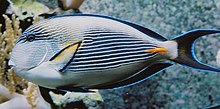Surgeon fish
| Acanthuridae Temporal range: Eocene to Recent |
|
|---|---|
 |
|
| Sohal surgeonfish, Acanthurus sohal | |
| Scientific classification | |
| Kingdom: | Animalia |
| Phylum: | Chordata |
| Class: | Actinopterygii |
| Order: | Perciformes |
| Suborder: | Acanthuroidei |
| Family: |
Acanthuridae Bonaparte, 1832 |
| Genera | |
Acanthuridae is the family of surgeonfishes, tangs, and unicornfishes. The family includes about 86 extant species. The family is composed of marine fish living in tropical seas, usually around coral reefs. Many of the species are brightly colored and popular for aquaria.
The distinctive characteristic of the family is the scalpel-like spines, one or more on either side of the tail ("thorn tails"), which are dangerously sharp. The dorsal, anal, and caudal fins are large, extending for most of the length of the body. The small mouths have a single row of teeth used for grazing on algae.
Surgeonfishes sometimes feed as solitary individuals, but they also often travel and feed in schools. Feeding in schools may be a mechanism for overwhelming the highly aggressive defense responses of small territorial damselfishes that vigorously guard small patches of algae on coral reefs.
Most species are relatively small and have a maximum length of 15–40 cm (6–15.5 in), but some members of the genus Acanthurus, some members of the genus Prionurus, and most members of the genus Naso can grow larger, with the whitemargin unicornfish (N. annulatus), the largest species in the family, reaching a length of up to 1 m (3 ft 3 in). These fishes can grow quickly in aquaria, so average growth size and suitability should be checked before adding them to a marine aquarium.
There are several extinct genera known from fossils dating from the Eocene to Miocene:
The name of the family is derived from the Greek words akantha and oura, which loosely translate to "thorn" and "tail", respectively. This refers to the distinguishing characteristic of the family, the "scalpel" found on each member's caudal peduncle. In the early 1900s, the family was called Hepatidae.
Tangs are very sensitive to disease in the home aquarium. However, if the tang is fed enough algae and the aquarium is properly maintained disease should not be a problem. It is usually necessary to quarantine the animals for a period before introducing them to the aquarium.
...
Wikipedia
